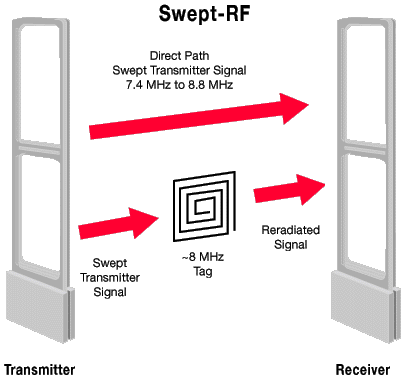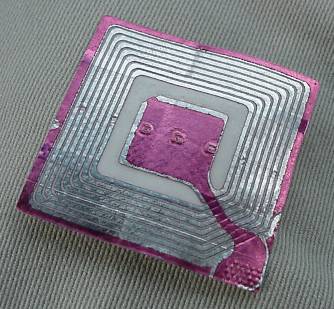How Anti-shoplifting Devices Work (4)

Radio Frequency Systems
Radio Frequency (RF) Systems are the most widely used systems in the United States today and RF tags and labels are getting smaller all the time. As you can see in the drawing at the right, the RF EAS system works like this: A label — basically a miniature, disposable electronic circuit and antenna — attached to a product responds to a specific frequency emitted by a transmitter antenna (usually one pedestal of the entry/exit gate). The response from the label is then picked up by an adjacent receiver antenna (the other pedestal). This processes the label response signal and will trigger an alarm when it matches specific criteria. The distance between the two gates, or pedestals, can be up to 80 inches wide. Operating frequencies for RF systems generally range from 2 to 10 MHz (millions of cycles per second); this has become standard in many countries. Most of the time, RF systems use a frequency sweep technique in order to deal with different label frequencies.
Sometimes both the transmitter and receiver are combined in one antenna frame — these are called mono systems and they can apply pulse or continuous sweep techniques or a combination of both. According to Tag Point Ltd. experts, mono systems could be effective for you if your store’s entry is small. The mono system is used with hard labels, which are slightly more expensive than paper labels used with RF sweep techniques.
Sensors (gates/pedestals) made by Checkpoint Systems, one of the largest manufacturers of EAS products, emit a low-energy RF pulse, which “listens” for the tag. This technology, known as digital signal processing, actually “learns” about its surroundings so that it can accurately distinguish between the tag signal and extraneous noise. Store employees love this because it virtually eliminates false alarms! (Store owners often ask why there are no invisible sensors. Cross Point experts say it is technically possible to create an invisible system by, for example, installing an antenna loop around a store’s door. However, tests have shown that the preventive value of a visible system is greater and results in decreased theft.)

This tag is about 1.5 inches (3 cm) square. On the other side is an innocuous paper label that says, “Thank you for shopping with us!”
There are many different ways to implement an RF system. The basic idea is that the tag has a helical antenna etched from thin aluminum bonded to a piece of paper. At the end of the antenna is a small diode or RC network that causes the tag to emit a radio signal in response to the radio signal it receives. To disarm the tag, a strong RF pulse (much stronger than the gates emit) blasts the tag and burns out the diode or RC components. Between the gates a burned out tag does not emit a signal, so the gates let it pass without an alarm.
